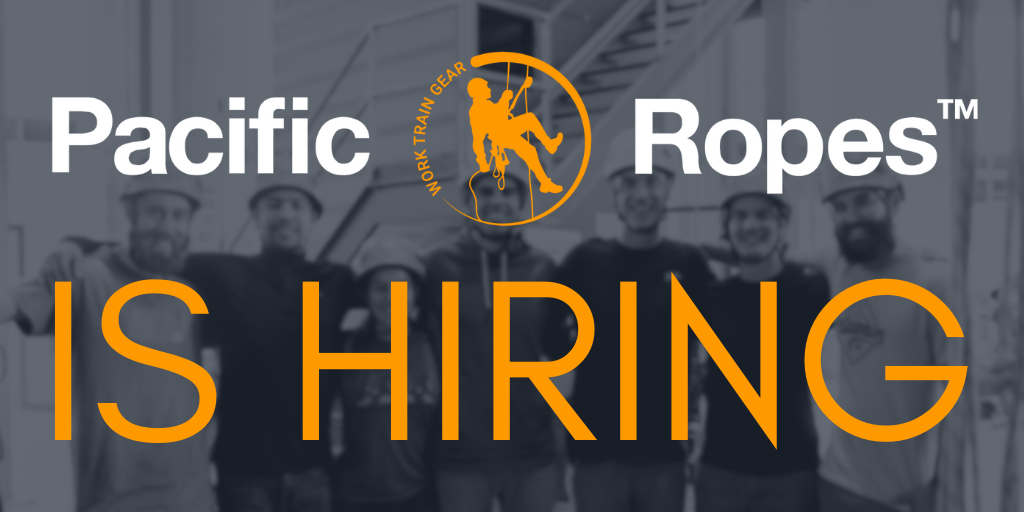The third safety component to understand is the structure and organization of Rope Access training. Simply put, if you don’t have training experience in Rope Access, you cannot go on rope to professionally practice Rope Access and complete work for any company.
There are three levels of certification within Rope Access in both the Industrial Rope Access Trade Association (IRATA) and the Society of Professional Rope Access Technicians (SPRAT) systems of training. In Level 1 training, a technician learns the basic system of Rope Access techniques. By the time a technician has graduated into Level 3, however, they are learning to become a Supervisor on a job site. For a Rope Access technician to move through the levels of certification, a certain amount of time and experience practicing rope access on a job site is mandatory.
Both hours on rope and work experience detail are documented in a Rope Access logbook, which is the most important piece of documentation any Rope Access Technician can have. It proves their hours on rope practicing Rope Access and it details a technician’s scope of work. Most importantly, each logbook entry is signed off and approved by a Level 3 Supervisor on site, so fraudulent work hours or job details cannot be logged. After a certain number of rope hours have been amassed, a technician gains the ability to move up the certification scheme. No hours or experience? No moving up the ladder of certification.
How does the training process work?
Once you've decided to becoming a rope technician, you enter a Level 1 certification training program, which involves 30 hours of theoretical and practical training and 1 assessment/evaluation. It is important to note here, that within IRATA and SPRAT, a third party outside of the training company performs the assessment/evaluation. This practice ensures impartial examinations, which ensures a standardization of skill and ability.
Once you pass your Level 1 assessment/evaluation, you now have a Level 1 certification and a Rope Access logbook. When you decide to upgrade to your Level 2, you must show the assessor/evaluator that you have completed 1000 Rope Access hours as a L1 technician and at least 1 year’s worth of work experience in the logbook. The 1000 hours you logged cannot have been completed in less than 1 year. The same goes for someone who wants to go from their Level 2 to Level 3. 1000 hours on rope and 1 year’s worth of work experience has to have been completed. It should be noted here that this requirement differs between IRATA and SPRAT. SPRAT has their own breakdown of hours between levels. They require 500 hours on rope and 6 month’s of work experience. Regardless of this difference, it is crucial that in order to advance through the 3 level system, you need to have gained experience and have spent a certain number of Rope Access hours on rope first.
Each level of certification requires 30 hours of training and another third party evaluation/assessment. Each level requires a technician to master new skills and techniques. It is very easy to under estimate the difficulty of Rope Access training. Training is physically demanding and requires an individual to remember all the steps that make up a series of rope and movement techniques! You will be amazed at the skills our Rope Access technicians encompass. Remember, Rope Access technicians can do more than just descend down a rope. They are capable of moving laterally along complex structures for work positioning, can perform self and team rescues on rope, and are still able to perform the work that needs to be completed in a number of applications. You get access + labor+ rescue when you hire a Rope Access technician!
As a Rope Access company, our Rope Access Operating Procedures state that we can only hire certified Rope Access technicians to work for us. Meaning they have been vetted and tested within the Rope Access training system and it is a standard procedure for us to have our certifications on site for you to review.
There are various other checks and balances in both the IRATA and SPRAT system of regulation regarding a Rope technician’s certification. From expired certifications to long periods of inactivity, both associations outline what needs to happen in order to keep a valid Rope Access certification. For example, if a rope tech has not worked for more than 6 months on rope, they will need to attend a refresher course in order to work on site. Again, this underlines our number one priority: absolute safety.
The take home message here is that our Rope Access associations are very diligent in making sure anyone with any level of Rope Access certification is competent and capable. Rope Access associations do not make it easy to gain certification and it’s not something you can just get online or forge.
When you invest in a legitimate Rope Access team, you can be confident that everyone is properly trained with the right amount of experience needed to stay safe, competent, and efficient.
Read more about Rope Access Safety here



